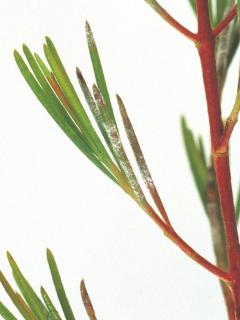Powdery mildew
There are significant differences in the susceptibility of wax hybrids to powdery mildew (Leveillula taurica). Many of the C. megalopetalum hybrids such as Blondie, Revelation and Madonna and the Verticordia plumosa hybrids such as Eric John, Jasper and Paddy’s Pink are much more susceptible to mildew infection than either straight C. uncinatum cultivars, or C. axillare hybrids.
Symptoms appear to differ between states. In Queensland there is little or no evidence of the usual powdery growth on tissue surfaces. Growers are advised to look for a banded chlorosis of the leaf and premature leaf drop.
In Western Australia there is frequently abundant powdery sporulation combined with rapid leaf drop of older affected foliage (Figures 4 and 5). With these symptoms, powdery mildew may be mistaken for Alternaria which often occurs at the same time but mainly as a secondary or opportunistic organism.
Powdery mildew can flourish under quite warm and dry conditions. The most favourable conditions for disease development are night temperatures of about 15ºC and high relative humidity, combined with day temperatures above 26.5ºC and relative humidity of 40 to 70%.
Powdery mildew spores are unusual as they do not require free water for germination. However, high humidities are necessary to start an infection and contact with a fine film of moisture promotes spore germination. The general principles of trying to avoid moisture on leaves for lengthy periods and maintaining good airflow around plants, apply to powdery mildew control on waxflower.
Powdery mildew is an obligate parasite. That is, it is only able to grow on living plant tissue. When the mildew-infected plant part dies the fungus dies with it unless perithecia are formed. These structures are the overwintering (sexual) stage of the fungus and are resistant to drying and other adverse environmental conditions.
Tomatoes and capsicums are infected by the same fungus, so do not plant waxes on the same ground or near where these crops are known to have been infected by powdery mildew any time within the previous two years.
Trials on roses showed that a 25mM solution (3.4g/L) of potassium dihydrogen orthophosphate (KH2PO4) plus a wetting agent gave good control of powdery mildew for 21 days. The chemical both eradicated the disease and prevented further development. Repeated applications at 6-12 day intervals increased this effect. This approach is worth trying on waxflower.
Registrations and permits for chemicals to control powdery mildew do change and you should refer to the APVMA website for current information on registered chemicals. Read the chemical label to determine the maximum numbers of applications allowed per season.


